Items used to repair speedometer
New Stepper Motors from eBay X25 168If you have bulbs that are burnt out you can find instruction and a video at Gauge Light Bulb Replacement for GM vehicles.
Speedometer Gauge Repair
Click on photos for larger version. If your General Motors vehicle is showing an incorrect speed, the speedometer stops working, the tachometer needle sticks or stops working, the fuel gauge flutters or if the entire instrument panel fails you have experienced what likely is a stepper motor (XC5.168) failure. Technical Service Bulletin 07187 was released to notify dealers and repair shops of this issue. 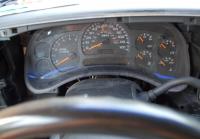 Chevrolet Silverado with defective stepper motors: GM will repair the gauges for free if you have less than 70,000 miles and the vehicle is less than seven years old. If you have between 70,000 and 80,000 they will pay for the part but not the labor. See General Motors Defective Speedometers for more information. If you have over 80,000 miles you are looking at a larger repair bill. $500 - $600 or even more has been reported as charges to replace the instrument cluster in Chevrolet, Cadillac, Buick, GMC and Pontiac vehicles. I will show you how to do the Speedometer Gauge Repair and replace the defective stepper motors yourself and save money. Set the parking brake and turn the key to the run position. Do not start the vehicle. Move the gear shifter to Low which will give you more room to remove the bezel and instrument cluster. Use the panel removal tool to pry the bezel surrounding the gauge cluster and radio loose. You might be able to get your fingers behind the bottom right corner and pull it loose without the tool. Pry the bezel loose all the way around the edges and remove it. Be careful not to apply too much pressure and break the surround.
Chevrolet Silverado with defective stepper motors: GM will repair the gauges for free if you have less than 70,000 miles and the vehicle is less than seven years old. If you have between 70,000 and 80,000 they will pay for the part but not the labor. See General Motors Defective Speedometers for more information. If you have over 80,000 miles you are looking at a larger repair bill. $500 - $600 or even more has been reported as charges to replace the instrument cluster in Chevrolet, Cadillac, Buick, GMC and Pontiac vehicles. I will show you how to do the Speedometer Gauge Repair and replace the defective stepper motors yourself and save money. Set the parking brake and turn the key to the run position. Do not start the vehicle. Move the gear shifter to Low which will give you more room to remove the bezel and instrument cluster. Use the panel removal tool to pry the bezel surrounding the gauge cluster and radio loose. You might be able to get your fingers behind the bottom right corner and pull it loose without the tool. Pry the bezel loose all the way around the edges and remove it. Be careful not to apply too much pressure and break the surround. 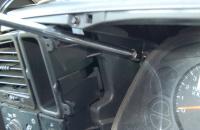 Remove screws with socket or nutdriver. You will then be able to see that there are four screws that hold the cluster into the dash. Some clusters have only tabs and clips. Use a 7mm socket or nut driver to remove the screws from the dash. Set them aside for later. You can then twist the instrument cluster around so you can access the wiring harness plug.
Remove screws with socket or nutdriver. You will then be able to see that there are four screws that hold the cluster into the dash. Some clusters have only tabs and clips. Use a 7mm socket or nut driver to remove the screws from the dash. Set them aside for later. You can then twist the instrument cluster around so you can access the wiring harness plug. 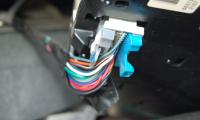 Instrument cluster connector Once you have it rotated you can shift the vehicle back into park and turn the ignition off. If you want to be extra careful you can remove the negative cable from the battery. You have to squeeze the two parts of the plug together to release the clip that holds the connector into the cluster. Once you have the connector clip released you can then pull the plug out of the cluster. Then you can remove the cluster from the vehicle. You can drive the vehicle without the cluster if you need. Just remember you won't be able to know how fast you are going -- of course if you are reading this article you likely have this same problem with the instrument cluster installed ;-) Take the cluster to a flat work area. If you are working on you kitchen table you may want to cover it to avoid getting solder on it. Use a screw driver or your fingers to unclip the fasteners holding the front cover of the instrument panel on.
Instrument cluster connector Once you have it rotated you can shift the vehicle back into park and turn the ignition off. If you want to be extra careful you can remove the negative cable from the battery. You have to squeeze the two parts of the plug together to release the clip that holds the connector into the cluster. Once you have the connector clip released you can then pull the plug out of the cluster. Then you can remove the cluster from the vehicle. You can drive the vehicle without the cluster if you need. Just remember you won't be able to know how fast you are going -- of course if you are reading this article you likely have this same problem with the instrument cluster installed ;-) Take the cluster to a flat work area. If you are working on you kitchen table you may want to cover it to avoid getting solder on it. Use a screw driver or your fingers to unclip the fasteners holding the front cover of the instrument panel on. 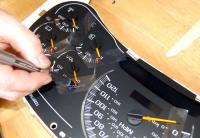 Mark dials with tape.Once they are all loose you can set the front panel aside. While it is off it is a good time to give the front a good cleaning. Set the panel down on the back so that the dials and faces of the gauges are up. Rotate all of the gauges counter-clockwise until they stop. Don't force them past where you feel tension or you will mess up the current calibration.
Mark dials with tape.Once they are all loose you can set the front panel aside. While it is off it is a good time to give the front a good cleaning. Set the panel down on the back so that the dials and faces of the gauges are up. Rotate all of the gauges counter-clockwise until they stop. Don't force them past where you feel tension or you will mess up the current calibration.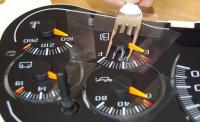 Remove dial pointers This will establish the location of where the dials should all be pointed when you finish replacing the stepper motors. Use a piece of Scotch tape or painters tape to mark the location of the dial pointer for each gauge. Place a piece of tape on the back of a fork and use it to pry the indicators off of the shafts. They may stick a little but they will come off. Unclip the fasteners holding the back panel and then you will have access to the circuit board. Depending upon your vehicle there maybe 4-7 or more motors.
Remove dial pointers This will establish the location of where the dials should all be pointed when you finish replacing the stepper motors. Use a piece of Scotch tape or painters tape to mark the location of the dial pointer for each gauge. Place a piece of tape on the back of a fork and use it to pry the indicators off of the shafts. They may stick a little but they will come off. Unclip the fasteners holding the back panel and then you will have access to the circuit board. Depending upon your vehicle there maybe 4-7 or more motors. 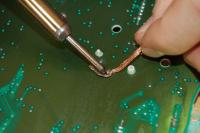 Desolder old motorsGo ahead and replace them all even if only one is acting up. The others will likely fail and it will be easier to do them all now while you have it apart and have the soldering iron hot.
Desolder old motorsGo ahead and replace them all even if only one is acting up. The others will likely fail and it will be easier to do them all now while you have it apart and have the soldering iron hot. 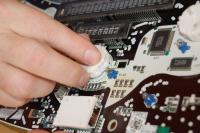 Install new stepper motorsUsing a soldering iron rated for electronics desolder and remove the old stepper motors. You can use a soldering wick to help with the removal of the solder. You may have to straighten the pins on the motor with a pliers or your fingers before you can pull the stepper motor out from the other side. You will notice that the motors have two pins on them, a large one and a smaller one. This is to make sure that they are installed in the correct orientation. Set the old stepper motors off to the side where you won't accidentally grab one and reinstall it. Push the new motors in place making sure that they seat in the holes.
Install new stepper motorsUsing a soldering iron rated for electronics desolder and remove the old stepper motors. You can use a soldering wick to help with the removal of the solder. You may have to straighten the pins on the motor with a pliers or your fingers before you can pull the stepper motor out from the other side. You will notice that the motors have two pins on them, a large one and a smaller one. This is to make sure that they are installed in the correct orientation. Set the old stepper motors off to the side where you won't accidentally grab one and reinstall it. Push the new motors in place making sure that they seat in the holes.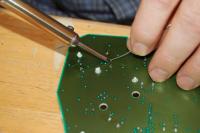 Solder in new stepper motors Make sure all of the pins go through the circuit board. You might need to clean out the holes before the new motors will go all the way in. Then solder all of the pins on each stepper motor.
Solder in new stepper motors Make sure all of the pins go through the circuit board. You might need to clean out the holes before the new motors will go all the way in. Then solder all of the pins on each stepper motor. 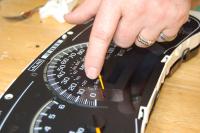 Realign dialsYou can now replace the back panel and turn the instrument cluster over with the face up. Push the dials back on with them pointing to the noon position. Rotate them to the left and try and line them up with the marks you made on the tape. If they won't go far enough left to line up with the marks push on them slightly so that they rotate on the shaft until they do line up. If they go too far left rotate them clockwise and turn the dial on the shaft. Then rotate to the left to see if it will line up. Repeat as needed. This step is easier to see in the video above.
Realign dialsYou can now replace the back panel and turn the instrument cluster over with the face up. Push the dials back on with them pointing to the noon position. Rotate them to the left and try and line them up with the marks you made on the tape. If they won't go far enough left to line up with the marks push on them slightly so that they rotate on the shaft until they do line up. If they go too far left rotate them clockwise and turn the dial on the shaft. Then rotate to the left to see if it will line up. Repeat as needed. This step is easier to see in the video above. 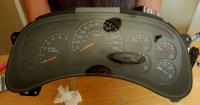 Ready to reinstallOnce all of the dials are in their correct positions make sure they are all seated and remove the tape. You can then snap the front cover back on and you are ready to reinstall the instrument cluster back into the vehicle. Plug the connector back in making sure it is seated and the retaining locks are activated. You can then set the parking brake, turn the ignition to run and shift into low gear. Twist the cluster back into position and put the four screws back in that you removed earlier. You can now reinstall the bezel. That is all there is to the Speedometer Gauge Repair of General Motors vehicles.
Ready to reinstallOnce all of the dials are in their correct positions make sure they are all seated and remove the tape. You can then snap the front cover back on and you are ready to reinstall the instrument cluster back into the vehicle. Plug the connector back in making sure it is seated and the retaining locks are activated. You can then set the parking brake, turn the ignition to run and shift into low gear. Twist the cluster back into position and put the four screws back in that you removed earlier. You can now reinstall the bezel. That is all there is to the Speedometer Gauge Repair of General Motors vehicles.
Items used in this "how to repair your GM Speedometer"
New Stepper Motors from eBay X25 168